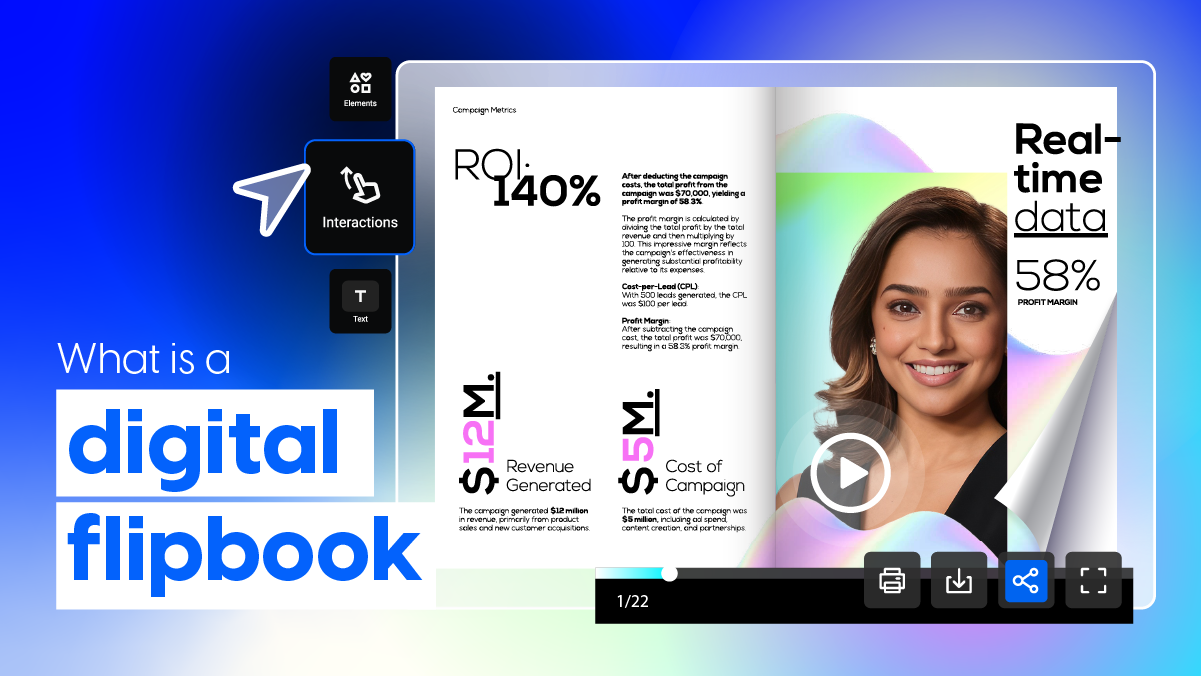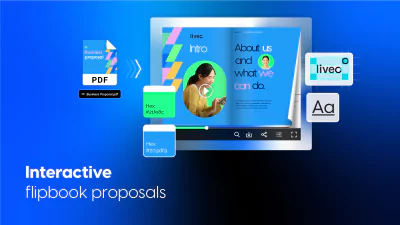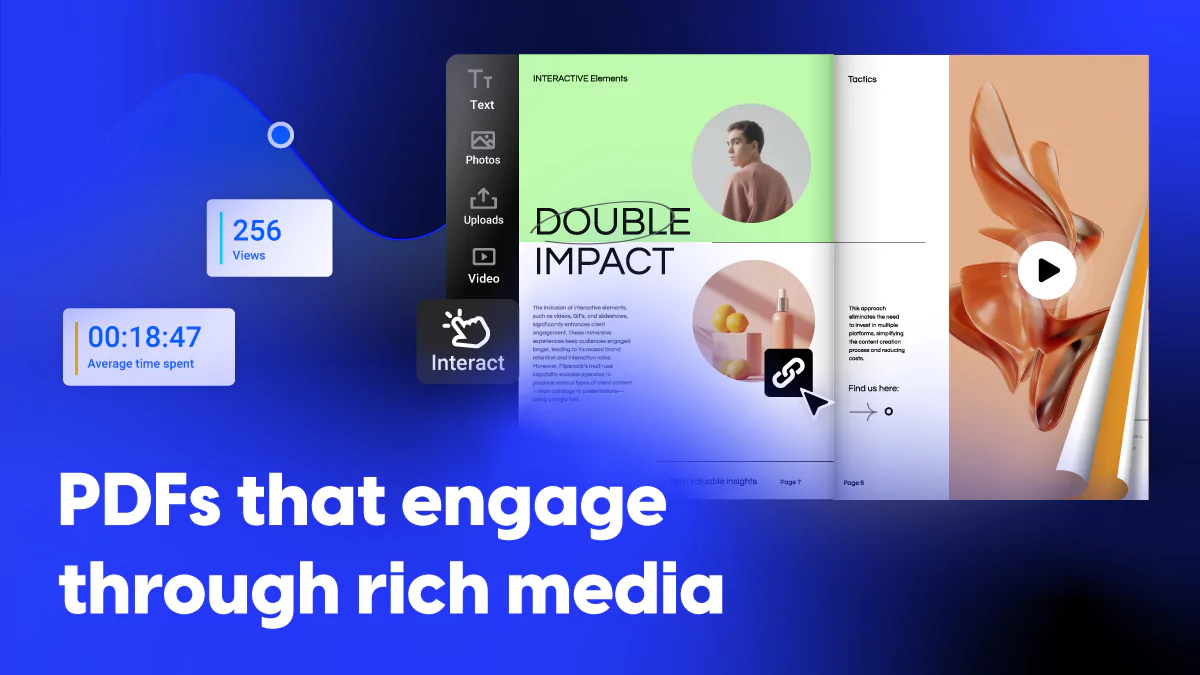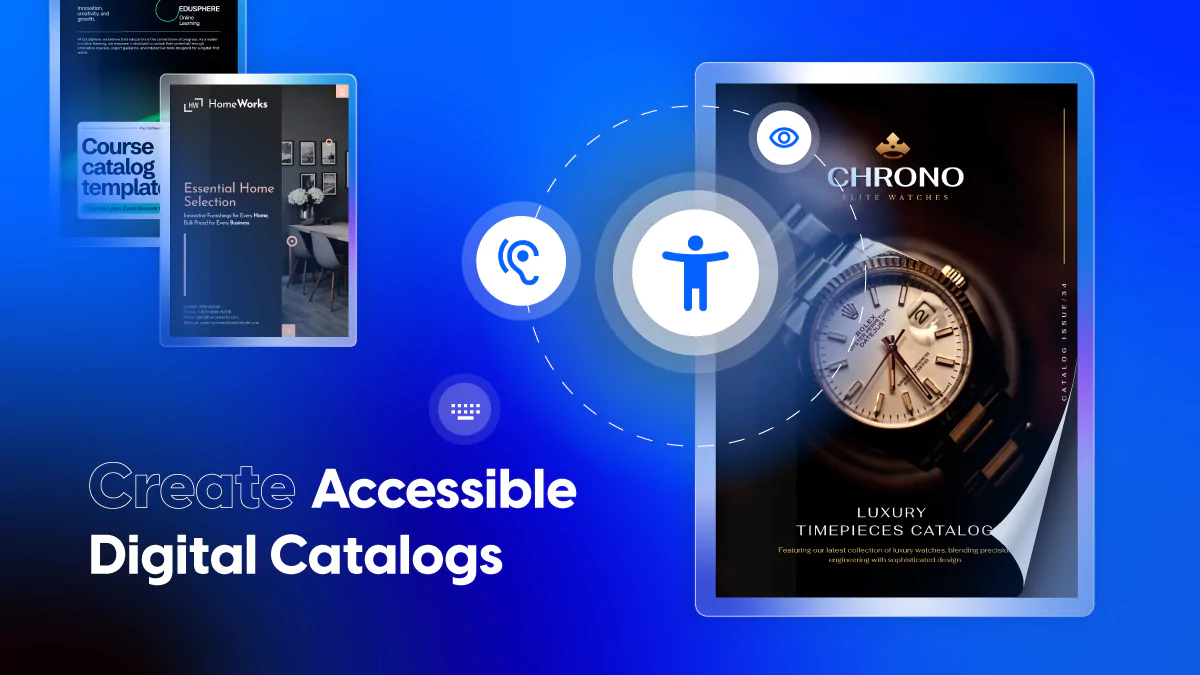What is a digital flipbook? The ultimate guide to creating and using flipbooks
Last updated: April 24th, 2025
If you’ve come across the term digital flipbook and wondered what it actually means, you’re in the right place. Whether you’re a marketer searching for a modern way to present brochures, an HR specialist looking to share interactive training materials, or a retailer in need of an online catalog display, digital flipbooks offer a versatile and engaging solution.
In this article, we’ll walk you through what a digital flipbook is, how you can easily create one, and why it’s becoming the go-to choice for digital publishing across industries. From key features and benefits to practical use cases and creation tips, we’ve got everything covered to help you get started—or to enhance what you’re already doing.
Table of contents
What is a digital flipbook?
A digital flipbook is a publication that simulates the experience of flipping through the pages of a physical book. It brings the tactile experience of reading into the digital age, with features that allow users to turn pages, zoom in, and click on embedded multimedia elements.
Flipbooks are created using modern web technology, enabling them to be fully responsive and interactive across devices, including desktops, tablets, and smartphones. Therefore, this makes them highly versatile for various applications, such as e-books, catalogs, presentations, and different marketing materials. Also, the technology ensures fast loading times and a great experience for users.
Flipbooks vs PDFs: Which is better?
While PDFs have been the principal way of creating and sharing digital documents, flipbooks offer a far more engaging and interactive experience. Let’s see in the following why flipbooks play a significant role in the way businesses communicate today.

Flipbook advantages:
- Better user experience: Flipbooks offer a dynamic interface that lets users interact with the content in meaningful ways. The ability to integrate multimedia elements such as videos, animations, and audio enhances the reader’s experience.
- Higher engagement rates: Flipbooks encourage interaction, keeping readers engaged longer by using links, embedded videos, and interactive animations.
- Easier navigation: Flipbooks come with features like search and bookmarking, and layouts that are easy to navigate, making it simple for users to find and engage with the content they care about.
Comparison with PDFs:
- Flipbooks often come with security features, and detailed analytics (such as tracking user’s behavior), and are optimized for mobile, which is often not the case with traditional PDFs.
- Flipbooks generally offer faster load times and smoother performance compared to large, static PDFs.
- Numerous businesses have found that interactive flipbooks lead to higher conversions and engagement compared to PDFs. For example, an online retailer using flipbook catalogs saw a significant increase in customer interaction through clickable product links, which later contributed to more sales.
How to create a digital flipbook in four easy steps
Creating a digital flipbook is easier than you might think. Whether you’re starting with an existing PDF or building your flipbook from scratch, here’s a step-by-step guide:

- Importing PDFs or starting from scratch: If you already have content in PDF format, most flipbook software like Flipsnack allows you to import it directly and convert it into a dynamic flipbook. Alternatively, you can design a flipbook from scratch using drag-and-drop editors.
- Customizing layout, colors, and fonts: Personalize your flipbook by choosing your preferred layout, adjusting fonts, and matching colors to your brand identity. This is a great way to maintain brand consistency and make your flipbook visually appealing.
- Adding multimedia elements: One of the key features that sets flipbooks apart is the ability to integrate multimedia elements. You can embed videos, images, audio, and links to make the experience more interactive.
Interactive features: What sets flipbooks apart
Flipbooks offer a wealth of interactive features that significantly enhance user engagement, driving stronger results compared to traditional static content. One of the most impactful advantages is the ability to integrate multimedia—such as videos, animations, and interactive forms—into the flipbook experience. This transforms passive reading into an immersive journey. Rather than simply reading about a product, users can engage with demo videos or complete interactive forms right within the flipbook, creating a more dynamic and memorable interaction.
Beyond engagement, flipbooks serve as effective tools for lead generation and content distribution. They allow for the seamless inclusion of call-to-action buttons, contact fields, and forms that capture user information as readers explore the content. Additionally, flipbooks are easily shareable across various platforms. Whether embedded on a website, included in an email campaign, or shared on social media, their versatile format boosts reach and encourages virality, helping brands connect with wider audiences in a more engaging way.
Different types of flipbooks that businesses create
The versatility of flipbooks makes them ideal for a variety of industries. Here are some of the most common use cases.
1. Marketing brochures/promotional materials
Flipbooks have transformed how brands present their products and services. Marketers use interactive flipbooks to create stunning catalogs, brochures, and lookbooks that present products in an engaging and visually appealing way.
- Product catalogs: Flipbooks enable businesses to create digital catalogs that contain links, embedded product videos, and interactive elements. Customers can zoom in on product images, view details, and even make purchases directly through integrated e-commerce functionality. For example, this is especially useful for fashion, retail, and real estate industries.
- Brochures and booklets: Brands can use flipbooks to design digital brochures and booklets that highlight new collections or services. By incorporating videos, animation, and clickable CTAs, flipbooks turn static marketing materials into dynamic, engaging digital experiences that drive user interaction and conversions.
- Digital newsletters: Flipbooks are an innovative way to enhance digital newsletters, turning static content into interactive experiences. For instance, businesses can create visually engaging newsletters that include embedded multimedia, such as videos, GIFs, and interactive links. The engaging design of flipbook newsletters helps improve click-through rates, making them a powerful tool for content marketing and brand storytelling.
- Flipbook for lead generation: Marketers can use flipbooks as lead magnets. Interactive forms and call-to-action buttons can capture user data, generating leads as users engage with the catalog or brochure.
2. Publishing industry (magazines, ebooks)
In the publishing industry, digital magazines and e-books have greatly benefited from the flipbook format, as it provides a rich, interactive reading experience. Flipbooks breathe new life into traditional publications by adding interactive elements that enhance reader engagement.
- Digital magazines: Publishers can convert traditional magazines into interactive flipbooks, enabling readers to engage with the content beyond just turning pages. With the ability to embed videos, galleries, and hyperlinks, flipbooks create a more immersive reading experience that boosts reader retention and satisfaction.
- E-books: Authors and publishers can present e-books as flipbooks, adding interactivity through animated chapter headings, embedded interviews or commentary, and links to additional resources. This makes the reading experience more engaging.
- Publishing portfolios: Flipbooks can also be used by publishers or creative professionals to present their portfolios. An interactive flipbook portfolio with embedded videos, high-resolution images, and other dynamic content can leave a lasting impression on potential clients or collaborators.
3. Corporate communication
Flipbooks are an excellent tool for presenting complex information in an engaging format for corporate communication. Corporate flipbooks are used for annual reports, presentations, and company updates.
- Annual reports: Instead of distributing lengthy, text-heavy PDFs, companies can create interactive annual report flipbooks. These reports can include dynamic charts, embedded videos, and sections that allow stakeholders to dive deeper into specific areas of interest by clicking on the links from the pages. This format makes the data from the reports more accessible.
- Corporate presentations: Businesses can create corporate flipbooks for client presentations or internal communication. These presentations can include multimedia elements like explanatory videos, interactive graphs, and infographics, providing a more impactful way to communicate complex information.
- Company newsletters: Using flipbooks to create company newsletters transforms traditional internal and external communications into interactive experiences. Employees can easily browse through updates, zoom in on specific content, and interact with embedded elements like event registration links, feedback forms, or direct access to detailed reports. Flipbook newsletters can highlight key company milestones, announcements, or industry insights. By studying successful examples of B2B newsletters, companies can further optimize their flipbook newsletters to include tailored content that resonates with their target audience and enhances engagement.
4. Education
In the educational sector, flipbooks offer a powerful tool for creating interactive textbooks, study guides, and lesson plans that enhance student engagement and improve the learning experience.
- Interactive textbooks: Flipbooks allow educators to create digital textbooks that go beyond text and images. By embedding instructional videos, audio clips, quizzes, and interactive diagrams, teachers can turn traditional learning materials into dynamic presentations. Students can access these textbooks on various devices, ensuring a flexible learning experience.
- Study guides and lesson plans: Teachers can use flipbooks to design interactive study guides and lesson plans. These can include step-by-step tutorials, glossaries, and multimedia explanations that help students understand concepts more easily. The fact that flipbooks are responsive on mobile devices makes them very accessible to students.
5. Event marketing
Event marketing flipbooks are an innovative way to provide event information, invitations, and programs in an engaging format. Therefore, flipbooks offer a professional and interactive way to share event details for corporate events and conferences.
- Event invitations: Flipbooks can replace traditional paper invitations with interactive flipbook invitations that include embedded videos, forms, and links to important event details. These invitations can be shared easily via email or social media.
- Event programs: Create interactive event programs that attendees can access digitally. These flipbook programs can include speaker bios, session schedules, maps, and links to additional resources or sponsors. Attendees can navigate through the program effortlessly on their devices, and organizers can update content in real-time as needed.
- Conference materials: Event organizers can distribute conference materials such as agendas, presentations, and flyers as interactive flipbooks. These materials can be accessed online or downloaded for offline use.
In each of these use cases, flipbooks offer a better alternative to traditional PDFs or printed materials, delivering a more engaging experience that meets the needs of modern digital users.
How to choose the right flipbook software
Choosing the right software for creating your flipbook is essential to ensure you get the most out of this dynamic format. With so many options available, it’s important to select a platform that offers the right mix of features, ease of use, and flexibility.

Flipsnack stands out as one of the best flipbook software options on the market. It offers an intuitive, user-friendly interface that makes creating professional and engaging flipbooks simple, even for beginners. Here’s why Flipsnack is the top choice for anyone looking to create high-quality, interactive digital flipbooks.
Wide variety of templates
Flipsnack provides a vast library of professionally designed templates for all types of flipbooks, from marketing brochures to educational materials. This makes it easy to get started and quickly customize your flipbook to suit your brand or project needs.
Multimedia integration
One of Flipsnack’s standout features is its ability to embed multimedia elements like videos, audio, and links. This transforms your static documents into interactive flipbooks that engage users.
SEO optimization
Flipsnack allows you to optimize your flipbooks for search engines by adding meta tags, keywords, and headings. This ensures that your digital publications are easily discoverable online, driving more traffic and engagement.
Analytics & tracking
With flipbook analytics, Flipsnack allows you to track how users interact with your content. You can monitor metrics such as time spent on each page, clicks on links, and overall engagement. This data helps you improve your content for better performance and higher conversions.
Mobile responsiveness
All flipbooks created with Flipsnack are mobile-responsive, meaning they will look and function perfectly on any device, whether it’s a desktop, tablet, or smartphone.
Customization options
Flipsnack gives you full control over the design and layout of your flipbook. You can customize fonts, colors, backgrounds, and more to match your branding and style preferences. This level of customization ensures that your flipbook design stands out and resonates with your audience.
In addition to these features, Flipsnack offers affordable flipbook pricing plans for individuals, small businesses, or enterprises, making it a versatile option for creators of all sizes. Whether you’re looking to convert a PDF to a flipbook, design from scratch, or create trackable flipbooks for marketing or education, Flipsnack provides the tools you need.
For more information on why Flipsnack is the top choice and how it compares to other online flipbook makers, check out our article with the best flipbook software on the market.
Start creating digital flipbooks with Flipsnack
As digital content continues to evolve, flipbooks represent the future of interactive and engaging online experiences. By choosing the right tools and strategies, you can create stunning digital publications that captivate audiences and drive results. With the knowledge you’ve gained from this guide, you’re well-equipped to start creating flipbooks and take your digital content to the next level.
FAQs about digital flipbooks
Yes, most flipbook software includes detailed analytics, allowing you to track user engagement, page views, and interactions with multimedia elements.
Flipbooks are fully responsive and adapt seamlessly to any device, including smartphones and tablets.
Absolutely! Flipbooks are a fantastic tool for lead generation. You can add call-to-action buttons, forms, and contact fields to generate leads directly from your flipbook.






